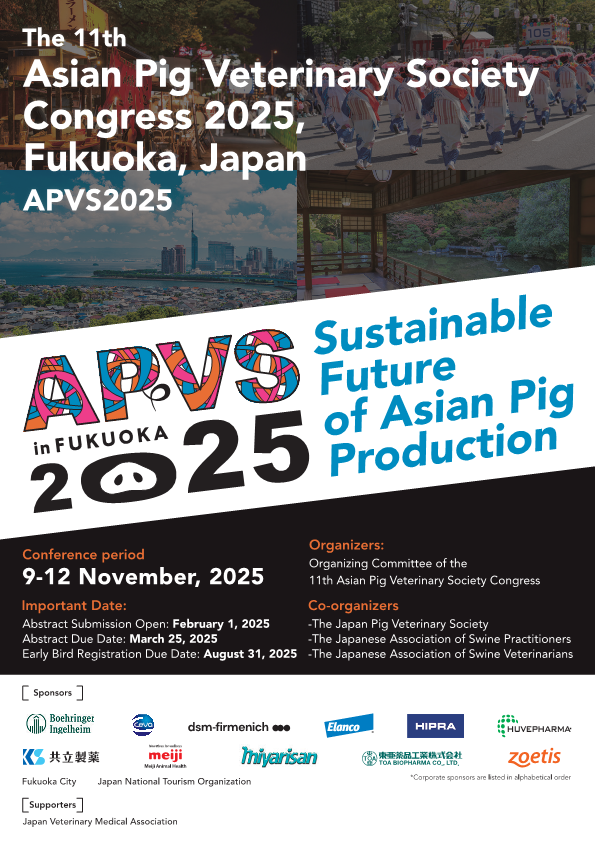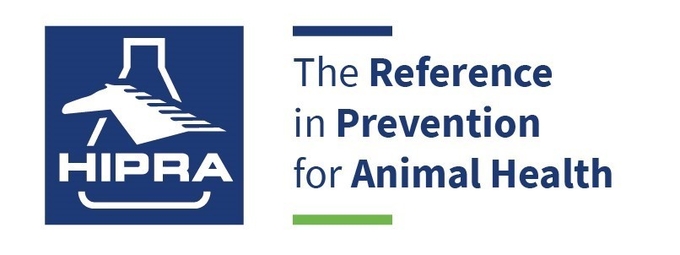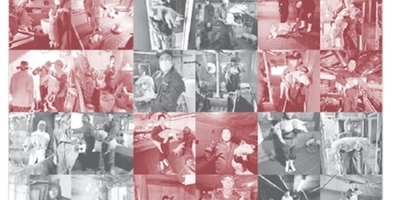모두가 양돈 현장에서 PRRS를 여러 차례 겪어 봤지만, 아직도 PRRS 컨트롤에 대한 '정답'은 없습니다. 오랜 기간 양돈농가를 괴롭혀온 만큼 PRRS에 대한 오해와 편견이 많이 쌓여있는 현실입니다. 'PRRS의 모든 지식'(총 15화)을 통해 우리 농장에 맞는 PRRS 컨트롤의 '해답'을 발견할 수 있길 기대합니다. 본 기고글은 HIPRA 본사에서 출간한 'The book for PRRS Knowledge"' 내용을 번역·정리한 것입니다.
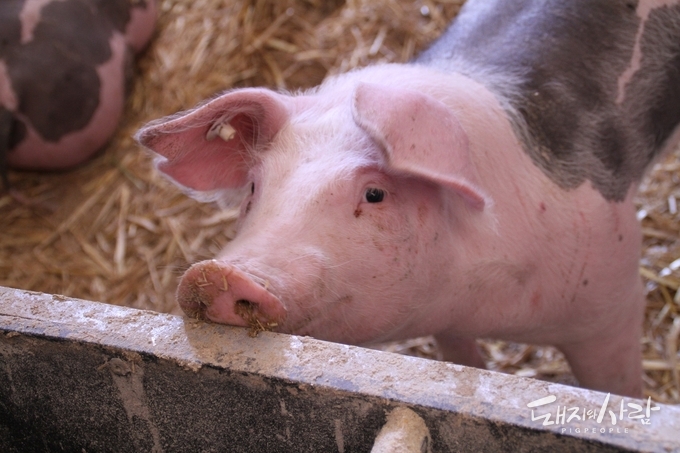
1화 PRRS의 개요와 역사
돼지생식기호흡기증후군(PRRS, Porcine reproductive and respiratory syndrome)이란?
이름에서 알 수 있듯, PRRS는 임상적으로 두 가지로 구분되는 병증을 나타내는 것이 특징입니다. 유산, 미이라 태자, 허약 자돈으로 대표되는 모돈의 번식 장애와 어린 돼지들의 호흡기 질환이 그것입니다.
이 질병은 1980년대 후반에 처음으로 인지되었으며, 원인체는 1991년에 분리되었습니다. 오늘날 PRRS는 대부분의 국가에서 풍토병 또는 유행병의 형태로 퍼져 있습니다.
첫 등장 이후 25년 이상이 지났지만, PRRS는 여전히 전 세계적으로 양돈 산업에 가장 큰 경제적 피해를 입히는 질병 중 하나입니다. 최근 한 연구에서는 미국에서의 PRRS에 의한 피해가 간접적인 비용을 제외하고서도 매년 6억 6,800만 달러에 달한다고 밝히고 있습니다. 또한, 2006년 중국의 고병원성 PRRS 발생은 불과 몇 달 동안 200만 마리의 돼지를 감염시켜 높은 폐사율을 유발하기도 했습니다.
PRRS를 통제하기 위한 첫 번째 백신은 사독 백신(inactivated strain)이었으며, 1993년에 출시되었습니다. 곧이어 약독화 생독 백신(modified-live strain) 또한 상용화되었습니다. 이후 몇 년간 사독 백신과 생독 백신 형태의 백신의 수는 많지 않았으나, 최근에는 기하급수적으로 늘어나고 있습니다.
현재는 특정 국가에서만 상용화된 백신을 포함하여 30개 이상의 백신이 존재합니다. 하지만 이 백신들의 PRRS 바이러스 감염에 대한 방어력은 완벽하지도, 보편적이지도 않습니다. 여기에는 두 가지 중요한 이유가 있습니다.
- PRRS 바이러스의 유전적 다양성은 매우 높다.
- PRRS 바이러스는 면역 반응을 심하게 변동시킨다.
그럼에도 불구하고 백신은 바이러스의 전파 위험을 낮추고 임상 증상을 완화시키는 등 경제적 이점을 제공하는 것 또한 사실입니다. 백신에 대한 이러한 모순적인 사실에서 알 수 있듯 PRRS에 대한 4,000편 이상의 논문이 나온 과학계의 노력에도 불구하고 이 질병은 완벽히 이해되어 정복되지 않았습니다. 중요한 궁금증들도 여전히 풀리지 않은 채 남아있습니다.
결론적으로, PRRS 바이러스는 전 세계에 걸쳐 퍼져 있으며 막대한 경제적 손실을 일으킵니다. 막대한 비용과 복잡한 통제·제거 작업을 시행한 이후에도 농장이나 지역, 국가 단위의 재유입도 자주 일어납니다. 이렇듯 PRRS는 양돈 산업에서 가장 위협적인 질병 중 하나입니다.
PRRS의 기원은 무엇일까?
1980년대 후반 임신 말기 모돈에서 심각한 번식 피해가 발생하며 그 동안 알려지지 않았던 질병이 처음으로 인지되었습니다. 이 질병은 자돈들에도 영향을 미쳤는데, 허약 자돈의 분만이 늘어나고, 신생자돈 및 자돈사의 폐사율이 증가하였으며, 성장 저하를 유발하는 심한 폐렴이 나타났습니다.
이 질병은 1987년 미국의 노스캐롤라이나(North Carolina)주에서 처음으로 발생 보고되었습니다. 몇 년 뒤인 1990년에는 독일의 뮌스터(Münster) 지역에서 비슷한 임상 증상이 확인되었습니다. 유럽과 북미, 두 지역의 발병에는 어떠한 연관성도 밝혀지지 않았습니다. 이후 이 질병은 전 세계로 빠르게 퍼져나가게 됩니다.
이 질병은 돼지 수수께끼 병(mystery swine disease), 돼지 청이병(blue-ear pig disease) 등 다양한 이름으로 불리다가, 1992년 미국에서 이 질병을 주제로 열린 첫 번째 국제 학회에서 현재의 이름인 '돼지생식기호흡기증후군(Porcine reproductive and respiratory syndrome)'이라는 명칭이 붙었습니다.
네덜란드 렐리스타트(Lelystad) 연구소는 돼지의 폐포 대식세포(alveolar macrophage)를 이용하여 원인체 바이러스를 분리하고 이 바이러스주를 'Lelystad virus(렐리스타트 바이러스)'라고 명명하였습니다. 분리된 병원체는 코흐의 원칙(Koch’s postulates, 어떤 병원체를 특정 질병의 원인체로 규명하는 감염발증학의 기초 원칙)을 충족하며, PRRS의 원인 바이러스임이 밝혀졌습니다. 이듬해에는 북미에서 발병한 사례에서도 CL-2621 세포주를 이용하여 병원체 분리에 성공하고, 이 바이러스주는 VR-2332로 명명되었습니다.
이들 분리 바이러스들을 이용한 초기의 유전적 분석 연구로 다음과 같은 내용들이 밝혀졌습니다.
- 두 바이러스는 같은 바이러스이나 유전형이 서로 다름(현재는 두 개의 다른 바이러스 종(PRRSV1과 PRRSV2)로 지정됨)
- 두 바이러스는 Arterivirus속의 바이러스들과 유사한 특성을 지님(2016년부터는 Paraterivirus로 불림)
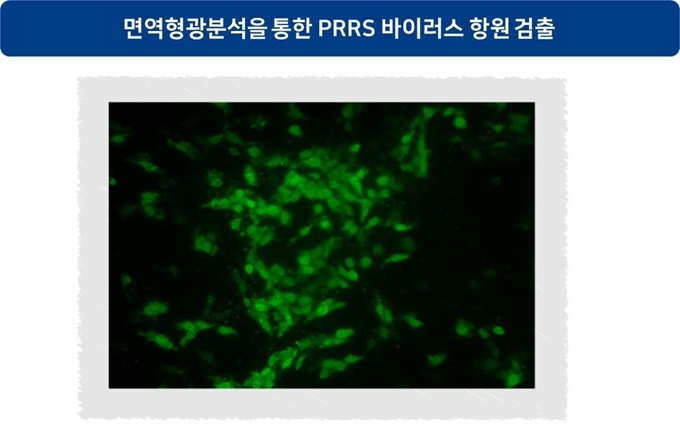
PRRS 바이러스 존재의 최초 증명은 후향성(Retrospective) 혈청학적 연구에서 비롯되었습니다. 1979년 캐나다에서 혈청에 포함된 항체를 검출한 것입니다. 미국에서의 후향성 분석은 1985년까지는 PRRS 바이러스의 존재를 규명하지 못했습니다. 하지만 최초의 임상적 발병이 보고된 1988년부터는 북미 지역의 유병율이 급격히 증가했습니다. 유럽에서도 비슷한 패턴으로 바이러스의 존재가 밝혀졌습니다. 아시아 대륙의 첫번째 PRRS 발병은 1988년 일본에서 보고되었지만, 후향성 분석으로 1985년 한국에서 혈청의 항체가 존재했음이 알려졌습니다. 이러한 사실들은 PRRS 바이러스가 최초의 발병이 보고되기 이전부터 이미 몇 년간 세계 각국의 돼지 농장에서 순환했을 가능성을 암시합니다.
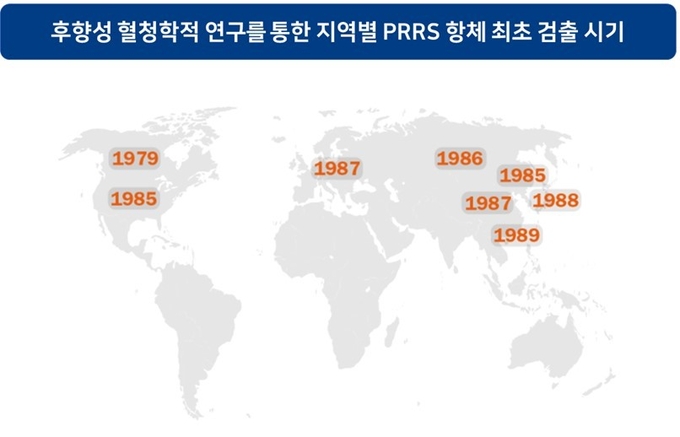
불가사의하게도 PRRS라는 질병은 두 가지의 다른 바이러스주(strain, 현재는 두 가지의 종 'species'으로 인식됨)들이 속해 있는 하나의 바이러스가 유발하는 질병입니다. 또한 이 질병은 세 개의 대륙에서 거의 동시에 등장했습니다. 이 현상의 배경을 명확히 설명할 방법은 없습니다. 그럼에도 불구하고 이 바이러스의 불명확한 기원을 추정하는 세 가지의 가설이 있습니다.
① 근래 발생설: PRRS 바이러스가 상업 돼지 농장에서 발병하기 불과 10여년 전에 최초로 생겨났을 것이라는 가설입니다. 이 가설에서 아주 짧은 기간 내에 두 개의 유전형이 등장한 것은 이는 이 바이러스의 변이율이 극도로 높다는 것을 암시합니다.
② 기존 바이러스 진화설: 각각의 유전형(genotype)이나 바이러스 종(species)들이 독립적으로 진화했을 것이라는 가설입니다. 이 가설에서 각 바이러스들의 공통 조상은 첫 번째 발병으로부터 최소 100년 전부터 존재했을 것으로 추정합니다. PRRS 바이러스의 유전자 중 ORF3을 분자 시계(molecular clock)으로 삼아 계산해보면, PRRS 바이러스는 1880±15년에 유래했을 것으로 추정됩니다. 즉 각 유전형은 돼지 농장에서 발병하기 전 각각 서로 다른 환경에서 수 세기 동안 진화했다는 것입니다. 이 가설은 2003년 미국 미네소타 대학의 Plagemann 교수가 제기한 가능성과도 일맥상통합니다. 그는 PRRS 바이러스가 동유럽 지역의 쥐에서 증식하는 다른 Arterivirus(LDV, Lactate dehydrogenase elevating virus)에서 유래했다고 주장했습니다. 이 조상 바이러스가 쥐에서 야생 멧돼지로 감염되고, 유럽의 멧돼지들을 미국의 사냥터로 이동시키는 과정에서 바이러스가 북미 지역에 퍼지게 되었다는 것입니다. 이로부터 바이러스는 두 대륙에서 각각 진화해왔으며, 양돈 생산 방식이 변화하면서 질병의 발생이 촉진되었다는 추측입니다. 이 가설은 분자 시계 분석과 일치하지만, 쥐와 야생 멧돼지를 공통 숙주로 가졌던 조상 바이러스가 존재했다는 증거는 없습니다.
③ 구 소련 유래설: 구 소련에 있던 PRRS의 조상 바이러스가 제2차 세계 대전 이후 유럽 중부와 서부에 유입되었다는 가설입니다. 마찬가지로 이후의 양돈 생산 방식의 변화와 종돈 및 정액의 이동이 바이러스의 확산과 질병 발생을 촉진했다는 것입니다. 북미 지역으로의 전파는 미니피그 수입 과정에서 일어났다는 추측도 있습니다.
참고 문헌
● Allan GM, McNeilly F, Ellis J, Krakowka S, Meehan B, McNair I, Walker I, Kennedy S. Experimental infection of colostrum deprived piglets with porcine circovirus 2 (PCV2) and porcine reproductive and respiratory syndrome virus (PRRSV) potentiates PCV2 replication. Arch Virol. 2000, 145:2421-9.
● Baron T, Albina E, Leforban Y, Madec F, Guilmoto H, Plana Duran J, Vannier P. Report on the first outbreaks of the porcine reproductive and respiratory syndrome (PRRS) in France. Diagnosis and viral isolation. Ann Rech Vet. 1992, 23:161-6.
● Benfield DA, Nelson E, Collins JE, Harris L, Hennings JC, Shaw DP, Goyal SM, McCullough S, Morrison RB, Joo HS, Gorcyca D, Chladek D. Characterization of swine infertility and respiratory syndrome (SIRS) virus (isolate ATCC VR-2332). J Vet Diagn Invest. 1992. 4, 127-133.
● Benfield D, Nelson J, Rossow K, Nelson C, Steffen M, Rowland R. Diagnosis of persistent or prolonged porcine reproductive and respiratory syndrome virus infections Vet Res. 2000, 31:71.
● Blaha T. The ”colorful” epidemiology of PRRS. Vet Res BioMed Central. 2000, 31:77-83.
● Brockmeier SL, Palmer MV, Bolin SR. Effects of intranasal inoculation of porcine reproductive and respiratory syndrome virus, Bordetella bronchiseptica, or a combination of both organisms in pigs. Am J Vet Res. 2000, 61:892-9.
● Carman S, Sanford SE, Dea S. Assessment of seropositivity to porcine reproductive and respiratory syndrome (PRRS) virus in swine herds in Ontario–1978 to 1982. Can Vet J. 1995, 36:776-7.
● Collins JE, Benfield DA, Christianson WT, Harris L, Hennings JC, Shaw DP, Goyal SM, McCullough S, Morrison RB, Joo HS, et al. Isolation of swine infertility and respiratory syndrome virus (isolate ATCC VR-2332) in North America and experimental reproduction of the disease in gnotobiotic pigs. J Vet Diagn Invest. 1992, 4:117-26.
● Cortey M, Díaz I, Martín-Valls GE, Mateu E. Next-generation sequencing as a tool for the study of Porcine reproductive and respiratory syndrome virus (PRRSV) macro- and micro- molecular epidemiology. Vet Microbiol. 2017. doi: 10.1016/j.vetmic.2017.02.002.
● Delrue I, Van Gorp H, Van Doorsselaere J, Delputte PL, Nauwynck HJ. Susceptible cell lines for the production of porcine reproductive and respiratory syndrome virus by stable transfection of sialoadhesin and CD163. BMC Biotechnol. 2010, 29:10:48.
● Díaz I, Darwich L, Pappaterra G, Pujols J, Mateu E. Different European-type vaccines against porcine reproductive and respiratory syndrome virus have different immunological properties and confer different protection to pigs. Virology. 2006, 351:249-59.
● Dobrescu I, Levast B, Lai K, Delgado-Ortega M, Walker S, Banman S, Townsend H, Simon G, Zhou Y, Gerdts V, Meurens F. In vitro and ex vivo analyses of co-infections with swine influenza and porcine reproductive and respiratory syndrome viruses. Vet Microbiol.2014, 169:18-32.
● Duan X, Nauwynck HJ, Pensaert MB. Virus quantification and identification of cellular targets in the lungs and lymphoid tissues of pigs at different time intervals after inoculation with porcine reproductive and respiratory syndrome virus (PRRSV). Vet Microbiol. 1997, 56:9-19.
● Fan P, Wei Y, Guo L, Wu H, Huang L, Liu J, Liu C. Synergistic effects of sequential infection with highly pathogenic porcine reproductive and respiratory syndrome virus and porcine circovirus type 2. Virol J.2013, 10:265.
● Forsberg R, Oleksiewicz MB, Petersen AM, Hein J, Bøtner A, Storgaard T. A molecular clock dates the common ancestor of European-type porcine reproductive and respiratory syndrome virus at more than 10 years before the emergence of disease. Virology. 2001, 289:174-9.
● Gómez-Laguna J, Salguero FJ, Pallarés FJ, Carrasco L. Immunopathogenesis of porcine reproductive and respiratory syndrome in the respiratory tract of pigs. Vet J. 2013, 195:148-55.
● Harms PA, Sorden SD, Halbur PG, Bolin SR, Lager KM, Morozov I, Paul PS. Experimental reproduction of severe disease in CD/CD pigs concurrently infected with type 2 porcine circovirus and porcine reproductive and respiratory syndrome virus. Vet Pathol. 2001, 38:528-39.
● He Q, Li Y, Zhou L, Ge X, Guo X, Yang H. Both Nsp1β and Nsp11 are responsible for differential TNF-α production induced by porcine reproductive and respiratory syndrome virus strains with different pathogenicity in vitro. Virus Res. 2015, 201:32-40.
● Hill H. Overview and history of Mystery Swine Disease (swine infertility/respiratory syndrome). Proceedings of the Mystery Swine Disease Committee Meeting, Livestock Conversation Institute, Denver, CO. 1990, 29–31.
● Hirose 0, Kudo H, Yoshizawa S, Hiroike T, Nakane T. Prevalence of porcine reproductive and respiratory syndrome virus in Chiba prefecture. J Jpn Vet Med Assoc. 1995, 48:650-3.
● Holtkamp DJ, Kliebenstein JB, Neumann EJ, Zimmerman JJ, Rotto HF, Yoder TK, Wang C, Yeske PE, Mowrer CL and Haley CA. Assessment of the economic impact of porcine reproductive and respiratory syndrome virus on United States pork producers. J Swine Health Prod. 2013, 21:72-84.
● Hirose O, Shibata I, Kudou H, Samegai Y, Yoshizawa S, Ono M, Nishimura M, Hiroike T, Kageyama K, Sakano T. Experimental infection of SPF piglets with porcine reproductive and respiratory syndrome (PRRS) viruses isolated from two farms. J Vet Med Sci. 1995, 57:991-5.
● Jung K, Renukaradhya GJ, Alekseev KP, Fang Y, Tang Y, Saif LJ. Porcine reproductive and respiratory syndrome virus modifies innate immunity and alters disease outcome in pigs subsequently infected with porcine respiratory coronavirus: implications for respiratory viral co-infections. J Gen Virol. 2009, 90:2713-23.
● Karniychuk UU, Nauwynck HJ. Quantitative changes of sialoadhesin and CD163 positive macrophages in the implantation sites and organs of porcine embryos/fetuses during gestation. Placenta. 2009, 30:497-500.
● Karniychuk UU, Geldhof M, Vanhee M, Van Doorsselaere J, Saveleva TA, Nauwynck HJ. Pathogenesis and antigenic characterization of a new East European subtype 3 porcine reproductive and respiratory syndrome virus isolate. BMC Vet Res. 2010, 4:6:30.
● Karniychuk UU, Nauwynck HJ. Pathogenesis and prevention of placental and transplacental porcine reproductive and respiratory syndrome virus infection. Vet Res. 2013, 44:95.
● Kavanová L, Matiašková K, Levá L, Štěpánová H, Nedbalcová K, Matiašovic J, Faldyna M, Salát J. Concurrent infection with porcine reproductive and respiratory syndrome virus and Haemophilus parasuis in two types of porcine macrophages: apoptosis, production of ROS and formation of multinucleated giant cells. Vet Res.2017, 48:28.
● Kitikoon P, Vincent AL, Jones KR, Nilubol D, Yu S, Janke BH, Thacker BJ, Thacker EL. Vaccine efficacy and immune response to swine influenza virus challenge in pigs infected with porcine reproductive and respiratory syndrome virus at the time of SIV vaccination. Vet Microbiol. 2009, 139:235-44.
● Keffaber KK. Reproductive failure of unknown etiology. AASP. 1989, 1: 2–10.
● Lawson SR, Rossow KD, Collins JE, Benfield DA, Rowland RR. Porcine reproductive and respiratory syndrome virus infection of gnotobiotic pigs: sites of virus replication and co-localization with MAC-387 staining at 21 days post-infection. Virus Res. 1997, 51:105-13.
● Leng X, Li Z, Xia M, Li X, Wang F, Wang W, Zhang X, Wu H. Mutations in the genome of the highly pathogenic porcine reproductive and respiratory syndrome virus potentially related to attenuation. Vet Microbiol. 2012, 157:50-60.
● Li Y, Zhou L, Zhang J, Ge X, Zhou R, Zheng H, Geng G, Guo X, Yang H. Nsp9 and Nsp10 contribute to the fatal virulence of highly pathogenic porcine reproductive and respiratory syndrome virus emerging in China. PLoS Pathog. 2014, 10(7):e1004216.
● Li J, Wang S, Li C, Wang C, Liu Y, Wang G, He X, Hu L, Liu Y, Cui M, Bi C, Shao Z, Wang X, Xiong T, Cai X, Huang L, Weng C. Secondary Haemophilus parasuis infection enhances highly pathogenic porcine reproductive and respiratory syndrome virus (HP-PRRSV) infection-mediated inflammatory responses. Vet Microbiol.2017, 204:35-42.
● Lindhaus W, Lindhaus B. Raetselhafte Schweinekrankheit. Prakt Tierarzt 1991, 5:423–5
● Loula T. Mystery pig disease. Agri-practice. 1991, 12:23–34.
● Loving CL, Brockmeier SL, Sacco RE. Differential type I interferon activation and susceptibility of dendritic cell populations to porcine arterivirus. Immunology. 2007, 120:217-29.
● Lu W, Sun B, Mo J, Zeng X, Zhang G, Wang L, Zhou Q, Zhu L, Li Z, Xie Q, Bi Y, Ma J. Attenuation and immunogenicity of a live high pathogenic PRRSV vaccine candidate with a 32-amino acid deletion in the nsp2 protein. J Immunol Res. 2014, 2014:810523.
● Lunney JK, Benfield DA, Rowland RR.Porcine reproductive and respiratory syndrome virus: an update on an emerging and re-emerging viral disease of swine. Virus Res. 2010, 154:1-6.
● Mardassi H, Massie B, Dea S. Intracellular synthesis, processing, and transport of proteins encoded by ORFs 5 to 7 of porcine reproductive and respiratory syndrome virus. Virology. 1996, 221:98-112.
● Martínez-Lobo FJ, Díez-Fuertes F, Segalés J, García-Artiga C, Simarro I, Castro JM, Prieto C. Comparative pathogenicity of type 1 and type 2 isolates of porcine reproductive and respiratory syndrome virus (PRRSV) in a young pig infection model. Vet Microbiol. 2011, 154:58-68.
● Mateu E, Diaz I. The challenge of PRRS immunology. Vet J. 2008, 177:345-51.
● Meng XJ, Paul PS, Halbur PG. Molecular cloning and nucleotide sequencing of the 3′-terminal genomic RNA of the porcine reproductive and respiratory syndrome virus. J Gen Virol. 1994, 75:1795-801.
● Meng XJ, Paul PS, Halbur PG, Lum MA. Phylogenetic analyses of the putative M (ORF 6) and N (ORF 7) genes of porcine reproductive and respiratory syndrome virus (PRRSV): implication for the existence of two genotypes of PRRSV in the U.S.A. and Europe. Arch Virol. 1995, 140:745-55.
● Meredith MJ. Review of porcine reproductive and respiratory syndrome. Pig Disease Information Centre, University of Cambridge, Cambridge, England. 1-24.
● Meulenberg JJ, Hulst MM, de Meijer EJ, Moonen PL, den Besten A, de Kluyver EP, Wensvoort G, Moormann RJ. Lelystad virus, the causative agent of porcine epidemic abortion and respiratory syndrome (PEARS), is related to LDV and EAV. Virology. 1993, 192:62-72.
● Meulenberg JJ, Hulst MM, de Meijer EJ, Moonen PL, den Besten A, de Kluyver EP, Wensvoort G, Moormann RJ. Lelystad virus belongs to a new virus family, comprising lactate dehydrogenase-elevating virus, equine arteritis virus, and simian hemorrhagic fever virus. Arch Virol Suppl. 1994, 9:441-8.
● Meulenberg JJ, Petersen-den Besten A, De Kluyver EP, Moormann RJ, Schaaper WM, Wensvoort G. Characterization of proteins encoded by ORFs 2 to 7 of Lelystad virus. Virology. 1995, 206:155-63.
● Morin M, Carpenter J, Poljack Z, Rivest J, Urizar L, Klopfenstein C, PRRS economic impact simulation tool for regional control and eradication projects in Canada. 2014 IPVS Congress. p 220.
● Murtaugh MP1, Elam MR, Kakach LT. Comparison of the structural protein coding sequences of the VR-2332 and Lelystad virus strains of the PRRS virus. Arch Virol. 1995, 140:1451-60.
● Murtaugh MP, Stadejek T, Abrahante JE, Lam TT, Leung FC. The ever-expanding diversity of porcine reproductive and respiratory syndrome virus. Virus Res. 2010, 154:18-30.
● Nauwynck HJ, Van Gorp H, Vanhee M, Karniychuk U, Geldhof M, Cao A, Verbeeck M, Van Breedam W. Micro-dissecting the pathogenesis and immune response of PRRSV infection paves the way for more efficient PRRSV vaccines. Transbound Emerg Dis. 2012, 59 Suppl 1:50-4.
● Nelson EA, Christopher-Hennings J, Drew T, Wensvoort G, Collins JE, Benfield DA. Differentiation of U.S. and European isolates of porcine reproductive and respiratory syndrome virus by monoclonal antibodies. J Clin Microbiol. 1993, 31:3184-9.
● Neumann EJ, Kliebenstein JB, Johnson CD, Mabry JW, Bush EJ, Seitzinger AH, Green AL, Zimmerman JJ. Assessment of the economic impact of porcine reproductive and respiratory syndrome on swine production in the United States. J Am Vet Med Assoc. 2005, 227:385-92.
● Nieuwenhuis N, Duinhof TF, van Nes A. Economic analysis of outbreaks of porcine reproductive and respiratory syndrome virus in nine sow herds. Vet Rec. 2012, 170:225.
● Ohlinger V.F., Pesch S., Bischoff C., History, occurrence, dynamics and current status of PRRS in Europe, Vet Res. 2000, 31: 86-87.
● World Organisation for Animal Health; World Animal Health Information Database Interface; OIE 2013.
● Pirtle EC, Beran GW. Stability of porcine reproductive and respiratory syndrome virus in the presence of fomites commonly found on farms. J Am Vet Med Assoc. 1996, 208:390-2. Plagemann PG. Porcine reproductive and respiratory syndrome virus: origin hypothesis. Emerg Infect Dis. 2003, 9:903-8.
● Plagemann PG. Lactate dehydrogenase-elevating virus and related viruses. In: Fields Virology, 3rd ed. Ed. Fields BN, Knipe DM, Howley PM, et al. 1105-20.
● Plana J, Vayreda M, Vilarrasa J, Bastons M, Rosell R, Martinez M, San Gabriel A, Pujols J, Badiola JL, Ramos JA, et al. Porcine epidemic abortion and respiratory syndrome (mystery swine disease). Isolation in Spain of the causative agent and experimental reproduction of the disease. Vet Microbiol. 1992, 33:203-11.
● Pol JM, van Leengoed LA, Stockhofe N, Kok G, Wensvoort G. Dual infections of PRRSV/influenza or PRRSV/Actinobacillus pleuropneumoniae in the respiratory tract. Vet Microbiol. 1997, 55:259-64.
● Reiner G. Genetic resistance – an alternative for controlling PRRS? Porcine Health Management 2016, 2:27.
● Renukaradhya GJ, Alekseev K, Jung K, Fang Y, Saif LJ. Porcine reproductive and respiratory syndrome virus-induced immunosuppression exacerbates the inflammatory response to porcine respiratory coronavirus in pigs. Viral Immunol. 2010, 23:457-66.
● Salines M, Barnaud E, Andraud M, Eono F, Renson P, Bourry O, Pavio N, Rose N. Hepatitis E virus chronic infection of swine co-infected with Porcine Reproductive and Respiratory Syndrome Virus. Vet Res.2015, 6;46:55. Shibata I, Yazawa S, Ono M, Okuda Y. Experimental dual infection of specific pathogen-free pigs with porcine reproductive and respiratory syndrome virus and pseudorabies virus. J Vet Med B Infect Dis Vet Public Health. 2003, 50:14-9.
● Shin JH, Kang YB, Kim YJ, Yeom SH, Kweon CH, Lee WY, Jean YH, Hwang EK, Rhee JC, An SH, Cho IS, Oh JS, Joo HS, Choi CS, Molitor TW. Sero-epidemiological studies on porcine reproductive and respiratory syndrome in Korea. I. Detection of indirect fluorescent antibodies. RDA J Agri Sci. 1993, 35: 572-6.
● SIP Consultors. Repercusión económica del PRRS. Lleida, Spain. 2013.
● Snijder EJ, Kikkert M, Fang Y. Arterivirus molecular biology and pathogenesis. J Gen Virol. 2013, 94:2141-63.
● Solano GI, Segalés J, Collins JE, Molitor TW, Pijoan C. Porcine reproductive and respiratory syndrome virus (PRRSv) interaction with Haemophilus parasuis. Vet Microbiol. 1997, 55:247-57.
● Solano GI, Bautista E, Molitor TW, Segales J, Pijoan C. Effect of porcine reproductive and respiratory syndrome virus infection on the clearance of Haemophilus parasuis by porcine alveolar macrophages. Can J Vet Res. 1998, 62:251-6.
● Stadejek T. Explore unexplored: origin of PRRSV revealed? In Proceedings of the European, Middle Eastern and Africa Society for Biopreservation and Biobanking (ESBB) conference. November 16-19. France.
● Thacker EL, Halbur PG, Ross RF, Thanawongnuwech R, Thacker BJ. Mycoplasma hyopneumoniae potentiation of porcine reproductive and respiratory syndrome virus-induced pneumonia. J Clin Microbiol. 1999, 37:620-7.
● Thacker EL, Thacker BJ, Young TF, Halbur PG. Effect of vaccination on the potentiation of porcine reproductive and respiratory syndrome virus (PRRSV)-induced pneumonia by Mycoplasma hyopneumoniae. Vaccine. 2000, 18:1244-52.
● Thanawongnuwech R, Brown GB, Halbur PG, Roth JA, Royer RL, Thacker BJ. Pathogenesis of porcine reproductive and respiratory syndrome virus-induced increase in susceptibility to Streptococcus suis infection. Vet Pathol. 2000, 37: 143-52.
● ThanawongnuwechR, Thacker B, Halbur P, Thacker EL. Increased production of proinflammatory cytokines following infection with porcine reproductive and respiratory syndrome virus and Mycoplasma hyopneumoniae. Clin Diagn Lab Immunol. 2004, 11: 901-8.Thanawongnuwech R, Thacker EL, Halbur PG. Effect of Porcine reproductive and respiratory syndrome virus (PRRSV) (isolate ATCC VR-2385) infection on bactericidal activity of porcine pulmonary intravascular macrophages (PIMs): In vitro comparisons with pulmonary alveolar macrophages (PAMs). Vet Immunol Immunopathol. 1997, 59:323-335.
● Terpstra C, Wensvoort G, Pol JM. Experimental reproduction of porcine epidemic abortion and respiratory syndrome (mystery swine disease) by infection with Lelystad virus: Koch’s postulates fulfilled. Vet Q. 1991, 13:131-6.
● Tian K, Yu X, Zhao T, Feng Y, Cao Z, Wang C, Hu Y, Chen X, Hu D, Tian X, Liu D, Zhang S, Deng X, Ding Y, Yang L, Zhang Y, Xiao H, Qiao M, Wang B, Hou L, Wang X, Yang X, Kang L, Sun M, Jin P, Wang S, Kitamura Y, Yan J, Gao GF. Emergence of fatal PRRSV variants: unparalleled outbreaks of atypical PRRS in China and molecular dissection of the unique hallmark. PLoS One. 200, 2:e526.
● Van der Linden IF, Voermans JJ, van der Linde-Bril EM, Bianchi AT, Steverink PJ. Virological kinetics and immunological responses to a porcine reproductive and respiratory syndrome virus infection of pigs at different ages. Vaccine. 2003, 21:1952-7.
● Van Gorp H, Van Breedam W, Delputte PL, Nauwynck HJ. Sialoadhesin and CD163 join forces during entry of the porcine reproductive and respiratory syndrome virus. J Gen Virol. 2008, 89:2943-53.
● Wang G, Song T, Yu Y, Liu Y, Shi W, Wang S, Rong F, Dong J, Liu H, Cai X, Zhou EM. Immune responses in piglets infected with highly pathogenic porcine reproductive and respiratory syndrome virus. Vet Immunol Immunopathol. 2011, 142:170-8.
● Wensvoort G, Terpstra C, Pol JMA, Lask EA, Bloemraad M, de Kluyver EP, Kragten C, van Butten L, den Besten A, Wagenaar F, Broekhuijsen JM, Moonen PJM, Zetstra T, de Boer EA, Tibben AhJ, de Jong MF, van’r Veld P, Groenland GJR, van Gennep JA, Voets MTh, Verheijden JHM, Braamkamp J. Mystery swine disease in the Netherlands: the isolation of Lelystad virus. Vet Q. 1991, 13:121–30.
● Wesley RD, Mengeling WL, Lager KM. Prior infection of nursery-age pigs with porcine reproductive and respiratory syndrome virus does not affect the outcome of transmissible gastroenteritis virus challenge. J Vet Diagn Invest. 1998, 10:221-8.
● White M. Blue ear disease of pigs. Vet Rec. 1991, 128:574.
● White M. The clinical signs and symptoms of “blue eared pig disease”. Pig Vet J. 1991, 28:62-8.
● Wills RW, Gray JT, Fedorka-Cray PJ, Yoon KJ, Ladely S, Zimmerman JJ. Synergism between porcine reproductive and respiratory syndrome virus (PRRSV) and Salmonella choleraesuis in swine. Vet Microbiol. 2000, 71:177-92.
● pig333.com/prrs/prrsv-infection-in-france-clinical-and-economic-impact_9563/
● thepigsite.com/articles/4490/danish-pig-research-centreannual-report-2012-prrs
● Yamane I, Kure K, Ishikawa H, Takagi M, Miyazaki A, Suzuki T, Shibahara T, Kubo M, Kobayashi H, Kokuho T, Tsunemitsu H. Estimation of economic loss due to porcine reproductive and respiratory syndrome in Japan.
● Yu J, Wu J, Zhang Y, Guo L, Cong X, Du Y, Li J, Sun W, Shi J, Peng J, Yin F, Wang D, Zhao P, Wang J. Concurrent highly pathogenic porcine reproductive and respiratory syndrome virus infection accelerates Haemophilus parasuis infection in conventional pigs. Vet Microbiol.2012, 158:316-21.
● Yun SI, Lee YM. Overview: Replication of porcine reproductive and respiratory syndrome virus. J Microbiol. 2013, 51:711-23.
● Zhang Q, Yoo D. PRRS virus receptors and their role for pathogenesis. Vet Microbiol. 2015, 177:229-41.
● Zimmerman J, Yoon K-J, Wills RW, Swenson SL. General overview of PRRSV: A perspective from the United States. Vet Microbiol. 1997, 55:187-96.
● Zhou Z, Ni J, Cao Z, Han X, Xia Y, Zi Z, Ning K, Liu Q, Cai L, Qiu P, Deng X, Hu D, Zhang Q, Fan Y, Wu J, Wang L, Zhang M, Yu X, Zhai X, Tian K. The epidemic status and genetic diversity of 14 highly pathogenic porcine reproductive and respiratory syndrome virus (HP-PRRSV) isolates from China in 2009. Vet Microbiol. 2011, 150:257-69.
● Zimmerman JJ, Benfield DA, Dee SA, Murtaugh MP, Stadejek T, Stevenson GW, Torremorell M. Porcine reproductive and respiratory syndrome virus (porcine arterivirus). In: 10th ed. Diseases of swine, Ed. Wiley-Blackwell. 2012, 31:463-86.











